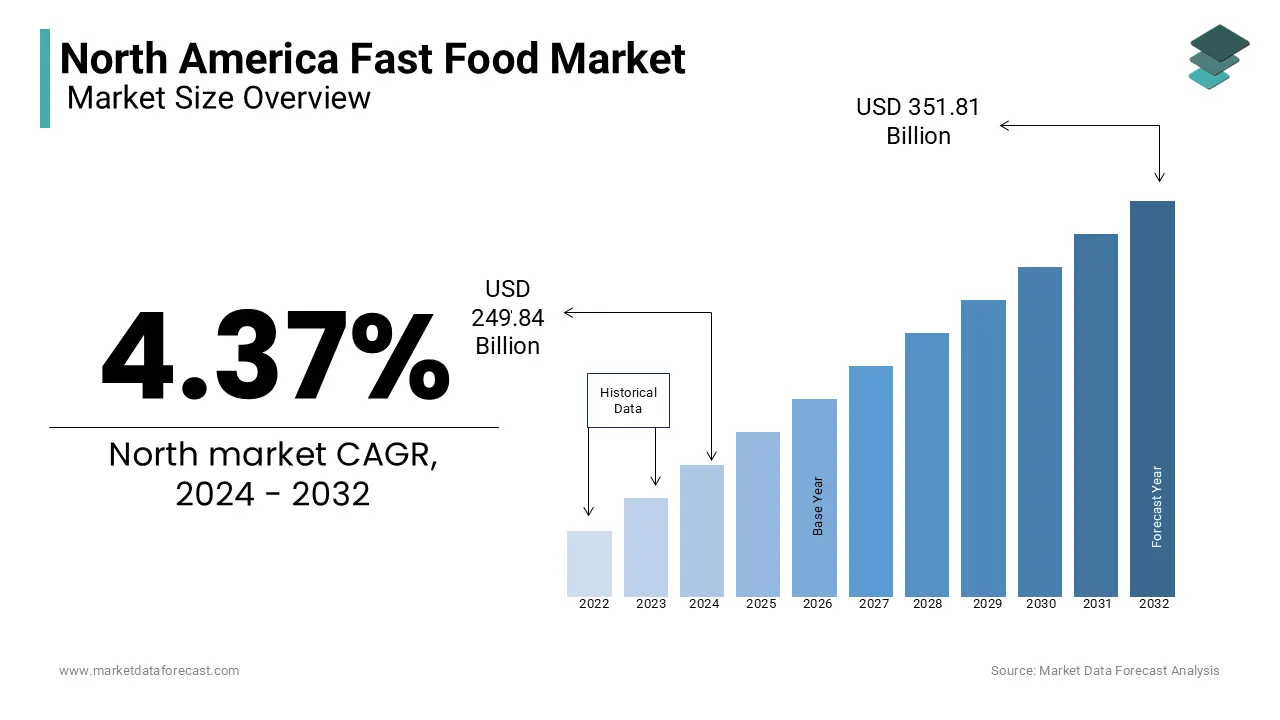North America Fast Food Market Research Report – Segmented By Type (Burger/Sandwich, Pizza/Pasta, Chicken & Seafood, Asian/Latin American Food, Others), Distribution Platform (Quick Service Restaurant (QSR), Street Vendors, Food Delivery Services, Online Food Delivery, Others), And Country (US, Canada And Rest Of North America) - Industry Analysis On Size, Share, Trends, COVID-19 Impact & Growth Forecast (2024 To 2032)
North America Fast Food Market Size (2024 to 2032)
The North America Fast Food Market is calculated to touch $ 351.81 Billion by 2032 from $ 249.84 Billion in 2024, at a CAGR of 4.37% during the conjecture time frame 2024 to 2032.

Fast food is the better choice of food for the general public that capacities at high speed. Fast foods and junk foods contain high levels of fats, sugar, and sodium. They are quick to get ready, have great taste, and are addictive. Additionally, this spares the cost of cooking in the kitchen, consequently making fast food practical. Fast food is made with fewer quality items that make them undesirable and less nutritious. Some fast-food dinners have included sugar not only does that mean additional calories, but additionally little nutrition.
The unmistakable components driving the North American fast food market development are changes in the patterns of shopper inclinations, a rising number of working populace, an increase in the number of drive-in joints, and an expanding number of worldwide cooking styles. High preparation costs and developing well-being mindfulness in individuals are hampering the market development during the gauge time frame. The huge difficulties in North America's fast food market are sanitation guidelines. The preparation of more beneficial foods is opening doors for the fast-food market development during 2020-2025.
The colossal driver in the North American fast food market is the widening number of urban people and their necessity for lively and speedier options for their dinner. In like manner, the extension in changing lifestyles and taste tendencies of the customers is conveyed, and developing nations are boosting the business. In like manner, developing food and refreshment affiliations are, in addition, expected to help this industry. The rise in the number of bistros and lodgings is credited to energetic urbanization and globalization, which, along these lines, depended on helping the movement of the fast-food market. Likewise, the rise in health information among clients and extended vitality for strong and brilliant food drive the market improvement. Their zone is a bit of a climb in concerns related to fast food. Investigators ensured that the use of fast food causes overweight, strength, and other clinical issues. The clinical issue is the best confinement in fast food market improvement. This rising concern has driven people to change from fast food to pleasing fast food. The local fast-food market is losing its bit of the general business to easygoing fast food.
This research report on the North America Fast Food Market is segmented and sub-segmented into the following categories.
North America Fast Food Market By Type

- Burgers & Sandwiches
- Pizzas & Pasta
- Asian/Latin American Food
- Chicken/Seafood
Among these, the pizza/pasta segment is foreseen to record a significant portion of the North America fast food market during the anticipated time. Nonetheless, the burger/sandwich section will develop in a considerable way in the local market over the same timeline.
North America Fast Food Market By Distribution Platform
- Quick Service Restaurant (QSR)
- Street Vendors
- Food Delivery Services
- Online Food Delivery
The quick-service restaurants hold the most substantial share of the North American fast food market that is likely to continue in the following years with the rising food truck and on-the-go culture in the locale. The online food delivery segment is also developing at a notable CAGR in the regional industry.
North America Fast Food Market By Region
- US
- Canada
- Mexico
By Region, the North American fast food market is bifurcated into the US, Canada, and Mexico. Among these, the US holds the biggest piece of the North American fast food market because of a bustling way of life, appeal for advantageous food, and solid changes in fast food market menus, and Canada is also determined to enlist at a most elevated development rate in the North American fast-food market. This is because of positive socioeconomics, more prominent urbanization, increment in fast food market patterns and high reception of the new cuisines in the neighborhood.
KEY MARKET PLAYERS
Major Key Players in the North America Fast Food Market are Domino's Pizza, Burger King, KFC, Subway, Dunkin' Donuts, McDonald's, Hardee's, Pizza Hut, Firehouse Subs, and Auntie Anne's
Related Reports
Access the study in MULTIPLE FORMATS
Purchase options starting from $ 2000
Didn’t find what you’re looking for?
TALK TO OUR ANALYST TEAM
Need something within your budget?
NO WORRIES! WE GOT YOU COVERED!
Call us on: +1 888 702 9696 (U.S Toll Free)
Write to us: [email protected]